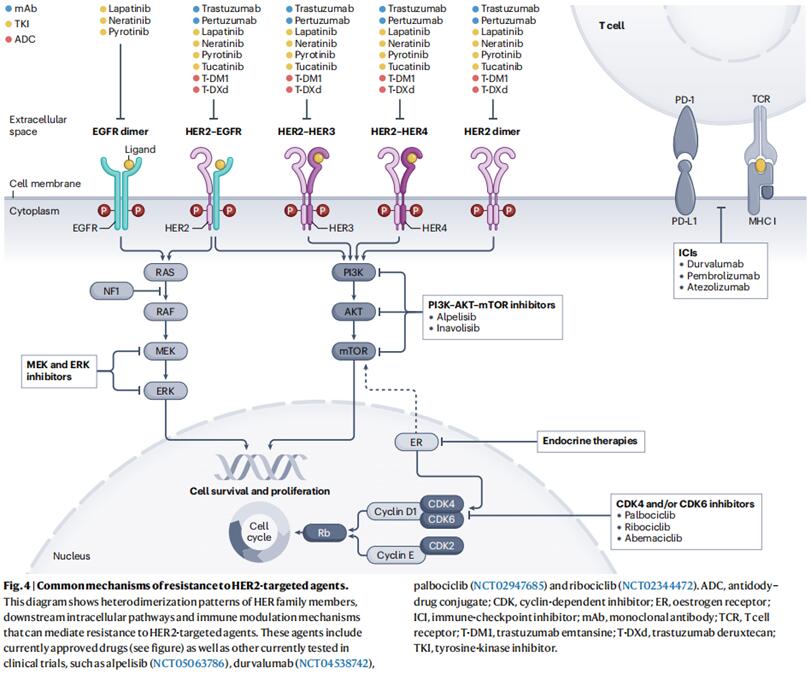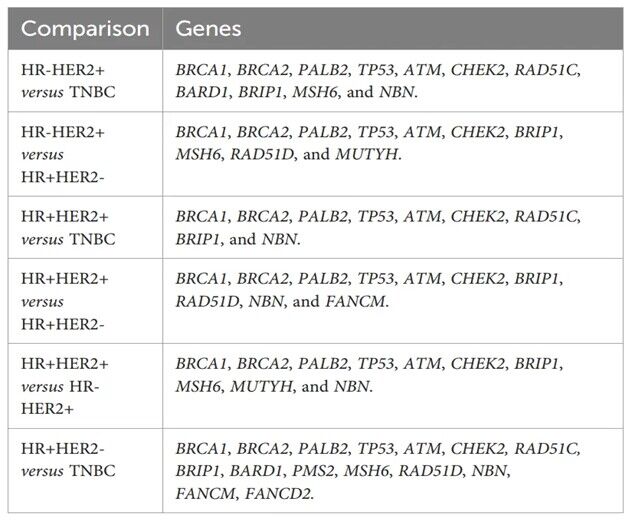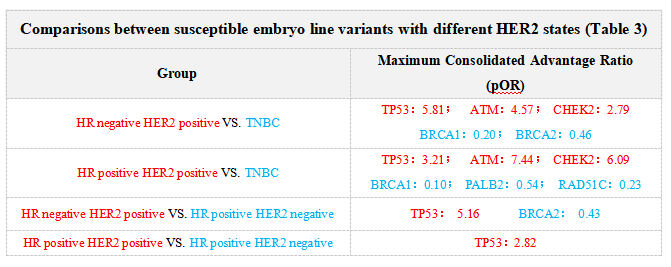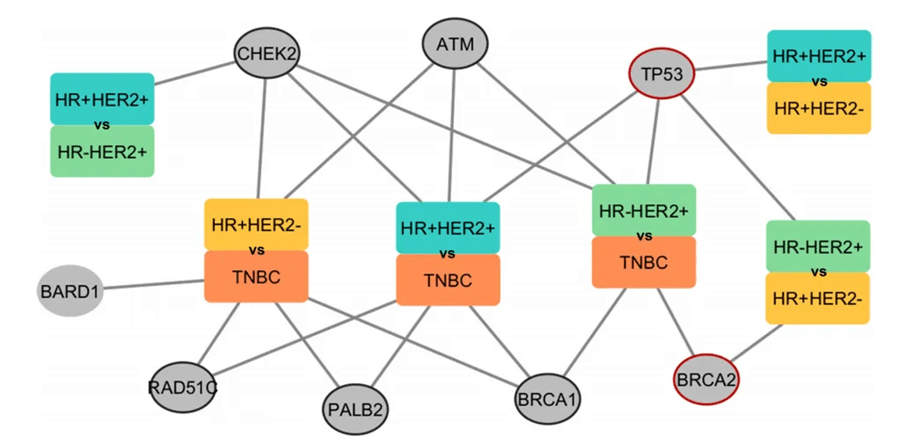Current location: Home > NEWS > Industry news
NEWS
PRODUCTS
HER2 is not simple, Care is not easy
News source: Release time:[2024-07-25]
Breast cancer is one of the most common cancers in women worldwide, and HER2-positive breast cancer (HER2+ BC) has attracted much attention due to its unique biological characteristics and poor prognosis. HER2-positive breast cancer accounts for 15-20% of all breast cancer cases and is highly malignant with a poor prognosis. In recent years, with the deepening of genomics research, people gradually realize the importance of genetic variation in the occurrence, progression and treatment of breast cancer.
At the beginning of 2024, Nature reviews published "Management of Patients with Advanced-Stage Her 2-Positive Breast Cancer: Current Evidence and Future Perspectives". This paper focuses on the promotion of molecular biology and drug development on targeted HER2 therapy and drug resistance mechanism research (Figure 1). The combination and sequential use of different targeted HER2 therapies improve the cure rate of early breast cancer and significantly prolong the survival time of patients with advanced breast cancer [1].

Figure 1 Common mechanisms of resistance to HER2-target agents
The researchers also outlined currently known factors associated with resistance to targeted HER2 therapy, such as intratumoral heterogeneity of HER2, activation of alternative signal pathways, and immune escape mechanisms, as well as possible future strategies to overcome this resistance and further improve patient outcomes. For example, the activation of signaling pathways that promote tumor progression when HER2 is blocked is also associated with resistance to targeted HER2 drugs by compensatory mechanisms, resulting in the reactivation of PI3K-AKT and RAS-MAPK pathways.
Breast cancer has a high degree of heterogeneity on the morphological and molecular levels, and genetic and epigenetics directly affect the prognosis and treatment of the disease. So, is there an association between breast cancer subtypes and embryopathogenic variants of cancer susceptibility genes? Front. Oncol, June 24 "Germlinerare Variants in HER2-Positive Breast Cancer Pre-Disposal: A Systemic Review and Meta-Analysis" [2]by Comparing HER2 Positive Subtypes with Other Milk Embryonal variation of susceptible gene in adenocarcinoma subtypes and found that the embryonal variation of TP53, ATM and CHEK2 were the susceptible factors for HER2 positive subtype, while the embryonal variation of BRCA1, BRCA2, PALB2, RAD51C and BARD1 were the susceptible factors for HER2 negative subtype with low expression.
A literature search conducted by the researchers from databases such as PubMed, Scopus, and EMBASE included the original studies investigating the embryogenic variation in patients with HER2-positive BC, and selected 36 studies that only reported rare and/or pathogenic embryogenic variation. A total of 11 studies provided data on the distribution of embryogenic variation of different clinically relevant BC subtypes, and the susceptibility between different BC subtypes was paired and analyzed. The genes included in each analysis are shown in Table 1.
Table 1 Genes Included in a Meta-Analysis of Comparison of Breast Cancer Subtypes

Through comparison of typing and grouping, it is not difficult to find that TP53 gene, which is involved in the regulation of cell cycle and DNA repair, ATM gene, which plays a key role in DNA double-strand break repair and is related to the prognosis of HER2-positive breast cancer, and CHEK2 gene, which plays a role in cell cycle regulation and DNA damage response, as important genetic variation genes, are involved in the occurrence, progression and prognosis of breast cancer. The data show the comparison between susceptible embryo line variations when the HER2 states are the same (Table 2) and the comparison between susceptible embryo line variations when the HER2 states are different (Table 3).

Note:If POR > 1, the case (red ) is more susceptible; the control group (fluorescent blue) was more susceptible if por < 1

Note:If POR > 1, the case (red ) is more susceptible; the control group (fluorescent blue) was more susceptible if por < 1
Common feature analysis of HER2 in different states
To better understand the genetic factors contributing to the susceptibility of different breast cancer subtypes, two groups of shared gene sequences containing embryogenic variants were compared and analyzed in this study. Through detailed comparative analysis of HER2 positive subtype and HER2 negative subtype, it was observed that the embryogenic variation of TP53 gene exhibited significantly different characteristics, specifically exclusivity, in the two subtypes (Figure 2). This finding highlights the crucial role of TP53 gene in the occurrence and development of breast cancer and further emphasizes its central position in cancer susceptibility.

Figure 2: Network showing comparisons and identification of individual genes predisposing to BC subtypes in a meta-analysis.
Circles represent relevant genes found in HER2-positive and HER2-negative comparisons.
The red circle represents the gene found in the HER2 positive associated with the HER2 negative.
In addition, the study also observed that the embryogenic variation of BRCA2 gene showed high consistency when compared with the HIR2 positive subtype only when compared with the triple negative breast cancer (TNBC) subtype, that is, the embryogenic variation of BRCA2 gene was only found to be susceptible to TNBC when compared with HIR2 positive (Fig. 2). This phenomenon reveals the differential role of BRCA2 gene in different subtypes of breast cancer and the deep-seated reason for the heterogeneity of breast cancer.
Meta-analysis and literature review studies have demonstrated that the TP53, CHEK2, and ATM embryogenic variants are significantly associated with HER2 positivity and may play a more complex role in HER2 overexpression. This finding deepens our understanding of the gene-specific risks associated with HER2 overexpression and provides important clues for the identification of key detection genes in the context of HER2-positive breast cancer (BC). These findings not only enhance our understanding of the genetic background of different subtypes of breast cancer, but also help guide gene exploration and disease prognosis by revealing the correlation of the gene subtype BC, provide a more accurate strategy for the management of hereditary breast cancer, improve the cure rate of the combination and sequential use of different targeted HER2 therapies for early-stage breast cancer, and provide an important scientific basis for improving the clinical prognosis of breast cancer patients.
References:
[1] Nat Rev Clin Oncol. 2024 Mar; 21(3):185-202.
[2] Front Oncol. 2024 Jun 24:14:1395970.